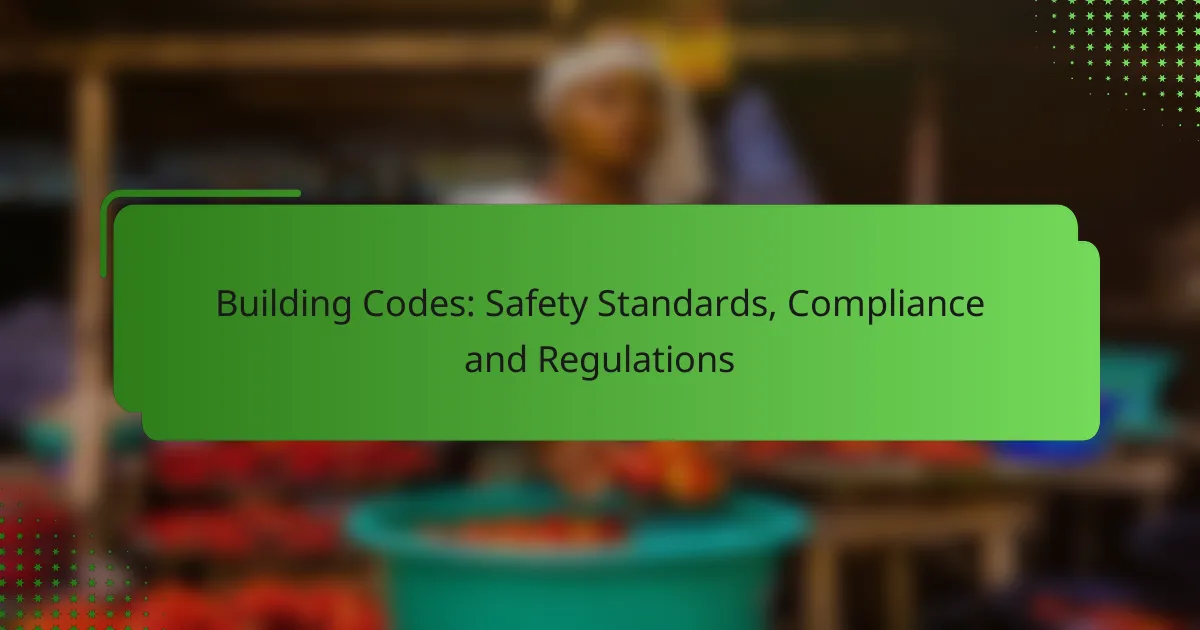Building codes are crucial regulations in the United States that ensure safety, structural integrity, and compliance in construction projects. They establish standards for various aspects of building design, including structural, electrical, and plumbing systems, aimed at protecting public health and minimizing risks. Adhering to these codes requires contractors to obtain permits, pass inspections, and maintain thorough documentation throughout the construction process.

What are the key building codes in the United States?
The key building codes in the United States are essential regulations that ensure safety, structural integrity, and compliance in construction. These codes provide a framework for various aspects of building design and construction, including structural, electrical, and plumbing systems.
International Building Code (IBC)
The International Building Code (IBC) is a comprehensive set of regulations that governs the construction of commercial and residential buildings. It covers aspects such as fire safety, structural integrity, and accessibility, ensuring that buildings are safe for occupants.
Adopting the IBC helps municipalities standardize building practices, which can simplify the permitting process. It’s crucial for builders and developers to familiarize themselves with the IBC, as it serves as a baseline for many local codes.
National Electrical Code (NEC)
The National Electrical Code (NEC) sets the standards for electrical installations in residential, commercial, and industrial buildings. It aims to protect people and property from electrical hazards by establishing requirements for safe electrical design, installation, and inspection.
Compliance with the NEC is mandatory in most jurisdictions, and it is updated every three years. Builders should ensure that all electrical work meets NEC standards to avoid safety risks and potential legal issues.
International Residential Code (IRC)
The International Residential Code (IRC) specifically addresses the construction of single-family homes and townhouses. It includes regulations for structural design, energy efficiency, and plumbing, ensuring that residential buildings are safe and livable.
Understanding the IRC is vital for contractors and homeowners alike, as it outlines the minimum requirements for residential construction. Local jurisdictions may adopt the IRC with amendments, so checking local regulations is essential.
Local Amendments
Local amendments are modifications to the national codes that reflect specific regional needs, climate conditions, or community standards. These amendments can vary significantly from one jurisdiction to another, impacting everything from energy efficiency requirements to seismic safety measures.
Builders must consult local building departments to understand any amendments that apply to their projects. Ignoring these local codes can lead to costly delays and compliance issues during the construction process.

How do building codes ensure safety standards?
Building codes ensure safety standards by establishing a set of regulations that govern construction practices, materials, and design. These codes are designed to protect public health, safety, and welfare by minimizing risks associated with structural failures, fires, and accessibility issues.
Fire safety regulations
Fire safety regulations are critical components of building codes that aim to prevent and mitigate fire hazards. These regulations typically require the installation of fire-resistant materials, smoke detectors, and sprinkler systems, depending on the building type and occupancy.
For instance, residential buildings may need smoke alarms in every sleeping area, while commercial properties might require more extensive fire suppression systems. Compliance with local fire codes can significantly reduce the risk of fire-related injuries and property damage.
Structural integrity requirements
Structural integrity requirements ensure that buildings can withstand various loads and environmental conditions, such as wind, earthquakes, and snow. Building codes specify design standards for materials and construction methods to maintain stability and safety.
For example, in earthquake-prone areas, codes may mandate reinforced concrete or steel frames to enhance resilience. Regular inspections during construction help ensure adherence to these structural standards, preventing future failures.
Accessibility standards
Accessibility standards within building codes ensure that structures are usable by individuals with disabilities. These standards typically include requirements for ramps, door widths, and restroom facilities that accommodate wheelchairs and other mobility aids.
In the United States, the Americans with Disabilities Act (ADA) outlines specific guidelines for accessibility in public buildings. Compliance not only enhances safety but also promotes inclusivity and equal access for all individuals.

What are the compliance requirements for contractors?
Contractors must adhere to various compliance requirements that ensure safety and quality in construction projects. These requirements typically include obtaining necessary permits, passing inspections, and maintaining proper documentation throughout the project lifecycle.
Permitting process
The permitting process involves obtaining official approvals from local authorities before commencing construction. Contractors must submit detailed plans and specifications that comply with local building codes and zoning regulations.
It is essential to check the specific requirements for your area, as they can vary significantly. Generally, contractors should allow several weeks to months for the permitting process, depending on the complexity of the project and local government efficiency.
Inspections and approvals
Inspections are critical to ensure that construction work meets safety standards and complies with approved plans. Various inspections may be required at different stages, such as foundation, framing, and final occupancy.
Contractors should schedule inspections promptly and be prepared for potential re-inspections if issues arise. Failing to pass an inspection can lead to project delays and additional costs, so thorough preparation is crucial.
Documentation and reporting
Maintaining accurate documentation and reporting is vital for compliance. Contractors should keep records of permits, inspection reports, and any correspondence with local authorities. This documentation serves as proof of compliance and can be essential in case of disputes.
Establishing a systematic approach to documentation can help streamline the process. Consider using digital tools to track progress and maintain records, ensuring that all necessary information is readily accessible when required.

What are the penalties for non-compliance with building codes?
Penalties for non-compliance with building codes can include financial fines, legal actions, and project delays. These consequences vary by jurisdiction and the severity of the violation, impacting both the project timeline and budget.
Fines and fees
Fines for failing to comply with building codes can range from a few hundred to several thousand dollars, depending on the nature of the violation and local regulations. Some jurisdictions may impose daily fines for ongoing non-compliance, which can accumulate quickly.
In addition to fines, there may be administrative fees associated with the inspection process or re-inspections required to ensure compliance. It’s crucial to budget for these potential costs when planning a construction project.
Legal repercussions
Legal repercussions for non-compliance can include lawsuits from affected parties, such as neighbors or local authorities. In severe cases, this may lead to criminal charges, especially if negligence results in injury or property damage.
Contractors and builders may also face license suspension or revocation, which can hinder their ability to operate in the future. Understanding local laws and maintaining compliance is essential to avoid these serious legal issues.
Project delays
Non-compliance can lead to significant project delays as authorities may halt construction until issues are resolved. This can extend timelines by weeks or even months, depending on the complexity of the violations and the speed of remediation efforts.
Delays can also result in increased costs due to extended labor and material expenses. To mitigate this risk, ensure thorough inspections and adherence to building codes throughout the construction process.

How do local building codes differ from national codes?
Local building codes are tailored to meet the specific needs and conditions of a community, while national codes provide a broad framework. This means that local regulations can vary significantly based on factors such as geography, climate, and community priorities.
Regional climate considerations
Building codes often reflect the climate of a region, addressing issues like snow load, wind resistance, and flood zones. For example, structures in hurricane-prone areas may require reinforced roofs and elevated foundations, while those in snowy regions must support heavy snow loads. Understanding these requirements is crucial for ensuring safety and compliance.
In areas prone to extreme temperatures, insulation standards may also differ, impacting energy efficiency and comfort. Builders should consult local codes to ensure they meet these climate-specific requirements.
Local zoning laws
Zoning laws dictate how land can be used and often influence building codes. These regulations can determine the type of structures allowed, their height, and their proximity to property lines. For instance, residential zones may have stricter codes than commercial areas, reflecting the community’s character and safety needs.
It’s essential for builders to review local zoning regulations before starting a project to avoid costly modifications or penalties. Engaging with local planning departments can provide clarity on these requirements.
Community safety needs
Community safety needs shape local building codes to address specific risks, such as fire hazards or seismic activity. For example, areas with a history of earthquakes may require buildings to adhere to stricter seismic standards, ensuring structural integrity during tremors.
Additionally, local codes may mandate features like fire-resistant materials or sprinkler systems in high-density housing. Builders should prioritize these safety measures to protect residents and comply with local regulations.

What are the emerging trends in building codes?
Emerging trends in building codes focus on sustainability, technology integration, and resilience against climate change. These trends aim to enhance safety, reduce environmental impact, and improve energy efficiency in construction practices.
Sustainable building practices
Sustainable building practices are increasingly incorporated into building codes to promote environmental responsibility. These practices include using renewable materials, optimizing energy efficiency, and minimizing waste during construction.
Key components of sustainable building codes often involve requirements for energy-efficient systems, such as HVAC and lighting, as well as water conservation measures. For instance, buildings may need to achieve a certain level of energy performance, often measured in terms of energy use intensity (EUI).
To comply with sustainable practices, builders should consider integrating features like green roofs, solar panels, and rainwater harvesting systems. Familiarizing oneself with local regulations, such as LEED or BREEAM certifications, can provide guidance on meeting sustainability standards effectively.










